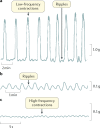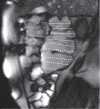First translational consensus on terminology and definitions of colonic motility in animals and humans studied by manometric and other techniques
- PMID: 31296967
- PMCID: PMC7136172
- DOI: 10.1038/s41575-019-0167-1
First translational consensus on terminology and definitions of colonic motility in animals and humans studied by manometric and other techniques
Abstract
Alterations in colonic motility are implicated in the pathophysiology of bowel disorders, but high-resolution manometry of human colonic motor function has revealed that our knowledge of normal motor patterns is limited. Furthermore, various terminologies and definitions have been used to describe colonic motor patterns in children, adults and animals. An example is the distinction between the high-amplitude propagating contractions in humans and giant contractions in animals. Harmonized terminology and definitions are required that are applicable to the study of colonic motility performed by basic scientists and clinicians, as well as adult and paediatric gastroenterologists. As clinical studies increasingly require adequate animal models to develop and test new therapies, there is a need for rational use of terminology to describe those motor patterns that are equivalent between animals and humans. This Consensus Statement provides the first harmonized interpretation of commonly used terminology to describe colonic motor function and delineates possible similarities between motor patterns observed in animal models and humans in vitro (ex vivo) and in vivo. The consolidated terminology can be an impetus for new research that will considerably improve our understanding of colonic motor function and will facilitate the development and testing of new therapies for colonic motility disorders.
Conflict of interest statement
The authors declare no competing interests.
Figures









References
-
- Phillips SF. Functions of the large bowel: an overview. Scand. J. Gastroenterol. Suppl. 1984;93:1–12. - PubMed
-
- Mearin F, et al. Bowel disorders. Gastroenterology. 2016;150:1393–1407. - PubMed
-
- Tabbers MM, et al. Evaluation and treatment of functional constipation in infants and children: evidence-based recommendations from ESPGHAN and NASPGHAN. J. Pediatr. Gastroenterol. Nutr. 2014;58:258–274. - PubMed
-
- Rudolph CD, Winter HS. NASPGN guidelines for training in pediatric gastroenterology. NASPGN Executive Council, NASPGN Training and Education Committee. J. Pediatr. Gastroenterol. Nutr. 1999;29:S1–S26. - PubMed
Publication types
MeSH terms
Grants and funding
LinkOut - more resources
Full Text Sources
Medical
Research Materials

